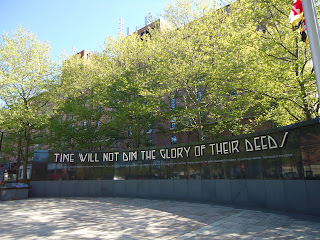Kudos to our friends and teammates, the Orioles, who are producing a video spot about "The Star-Spangled Banner" to educate fans about the celebrations surrounding the War of 1812 Bicentennial.
Not only does Baltimore have a special relationship with the song we revere as our National Anthem, but so does baseball. It is as much a Major League ritual as exchanging line-ups at home plate.
So how did that come about?
A little online digging produced several anecdotes about "The Star-Spangled Banner" and ball games, some going all the way back to the earliest days, when brass bands serenaded fans with popular melodies.
However, there is one particular incident, recounted in the September 6, 1918 New York Times, that describes an episode that may mark the beginning of the treasured tradition.
1918 was a particularly dark time for the United States, which entered World War I the year before. Casualties were devastating, the deadly Spanish Flu was sweeping the nation, and there was social unrest on the home front.
With many players on active duty, the 1918 season was abbreviated, ending on Labor Day. The World Series between the Cubs and Red Sox was the only time the fall classic would be played entirely in September. It opened in Chicago, just one day after a bomb exploded in a federal courthouse – supposedly set by labor activists, anarchists, or a combination thereof.
So it was against this tumultuous background the Series opened September 5
th on the South Side of Chicago, where the larger Comiskey Park was leased to accommodate more fans.
However, by the seventh inning stretch, a modest and somewhat indifferent crowd of about 19,000 had been sitting through an unexciting 1-0 pitchers duel.
The restless fans were still shuffling on their feet when the brass band struck up "The Star-Spangled Banner."
Now remember, "The Star-Spangled Banner" was not the National Anthem at the time. It was one of many patriotic melodies performed at public gatherings.
It wasn’t as stately as "Hail Columbia," as singable as "America," or catchy as "Columbia, Gem of the Ocean." But it had devotees in high places.
In 1889, Secretary of the Navy Benjamin Tracy (seen here with a band aboard the USS "Dolphin") ordered "The Star-Spangled Banner" played at all Navy flag-raising ceremonies.
In 1916, as war loomed, President Woodrow Wilson, also a fan of the inspiring lyrics, decreed that it be played at military and other appropriate occasions. Perhaps that prompted what happened next.
The Red Sox were taking the field when the melody began. Third baseman Fred Thomas, an active-duty serviceman on leave from the Navy, immediately stopped. He doffed his cap and turned towards the flagpole in right field, standing at military attention.
The gesture was not lost on his teammates, who likewise faced the flag, hands over hearts. Even the starting pitcher, warming up on the sidelines, stopped tossing as the song played.
The reaction of the crowd is best described in The New York Times:
"First the song was taken up by a few, then others joined, and when the final notes came, a great volume of melody rolled across the field. It was at the very end that the onlookers exploded into thunderous applause and rent the air with a cheer that marked the highest point of the day's enthusiasm."
In the stands was Harry Frazee, the Broadway producer who purchased the Red Sox a few years earlier with money from his theatrical successes. He knew a show-stopping hit when he heard one. He also realized it would work far better as an opening number than buried somewhere in the second act.
So when the Series moved to Fenway Park, Harry did the Cubs one better. He invited World War I veterans as guests, and had the "Star-Spangled Banner" played before the game as a tribute to them. As the impresario predicted, it got things off to a rousing start.
So he repeated it for the remaining games in Boston, to more ovations.
From the Chicago Tribune:
"Another delegation of wounded soldiers and sailors invalided home saw the game, and their entrance on crutches supported by their comrades evoked louder cheers than anything the athletes did on the diamond."
The Sox eventually won the Series in six games. The talented southpaw who completed the first game would pitch another shutout in Game 4, establishing a record of 29 scoreless innings in World Series play that stood until Whitey Ford topped it in the 60's.
It was the last time the Sox would win a World Series until 2004.
In 1919, Harry Frazee wanted to produce a promising musical. Cash-strapped because of poor box office receipts during the war, he needed to liquidate assets to finance the show. So he sold his pitcher, who was also his best hitter (but a bit of a problem child) to the New York Yankees for the unheard of sum of $125,000.
Eventually, "No, No Nanette" would be a smash on Broadway. But the Babe from Baltimore would be an even bigger hit in the Bronx, where they built a palace in his honor a few years later.
Still, Harry Frazee can take some credit for producing an overture with an even greater legacy than anything he ever did on the Great White Way.
The "Star-Spangled Banner" became the official National Anthem by an Act of Congress in 1931.
When the country was again at war in 1942, the National Pastime embraced its message of hope, pride, and resilience by playing it at the beginning of every game. The tradition became a treasured part of American, as well as baseball, culture.
Today, of course, you hear the National Anthem at sports events of every kind -- often accompanied by flyovers, fireworks, lasers, and other special effects. But to those of us who grew up in post-war Maryland, the last two words of the "Star-Spangled Banner" will always be —
"PLAY BALL !!!!!"






























